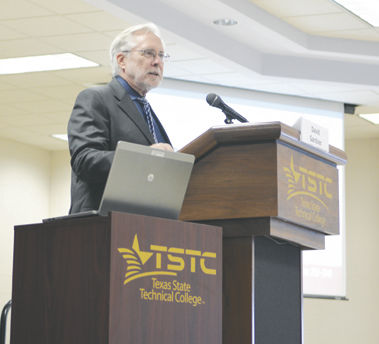HARLINGEN — With the zeal of an evangelist, the state’s higher education deputy commissioner for academic planning and policy delivered his vision for the future of Texas’s colleges and universities.
“My religion is education, and I think yours is, too,” David Gardner told an audience of teachers, professors and administrators at Texas State Technical College yesterday.
Gardner was speaking at the fifth of seven public policy forums across the state on behalf of the Texas Higher Education Coordinating Board.
The occasion was part of a policy tour for “60x30TX,” the THECB’s strategic plan for 2015 through 2030. At its core is a commitment to raising the number of Texans ages 25 to 34 who have certificates, bachelors or masters degrees from the current 38 percent to 60 percent.
Like much of contemporary higher education, the 60x30TX plan tries to address a number of issues in an increasingly complex matrix. Those include how to minimize student debt, the role of community colleges, maximizing opportunities for Hispanic students as well as male students and how to prepare students for the kind of jobs the economy of the future will demand.
Among his wide-ranging commentary on issues 60x30TX must address, Gardner said:
H “In the national media, you’d think every student who graduates has $150,000 to $200,000 in debt. Well, it’s not true in Texas … but we’re not doing students any good if we graduate them with so much debt that they can’t choose their career and they can’t really pay off their debt. … Fifty percent of our students have debt.”
H “Many people in the business community didn’t think that getting a certificate from a community college, getting an associate’s degree from a community college, was going to count. That IS going to college. We stress this, it’s very important.”
H “We need more males. Males in general are just not going to college or graduating at the level they should.”
H “Right now about 54 percent of our students go directly from high school to college. That needs to be at 65 percent by the time we get to 2030.”
H “Part of our plan is that every program has to have identifiable marketable skills. That’s a challenge. Because what’s a marketable skill now may not be two years from now, three years from now, four years from now. Once we get this started, we’re going to have to keep up on this.”
The seven regional meetings are designed to gather feedback on 60x30TX as well as to serve as a fire starter of sorts to kindle new ideas on how to reach the strategic plan’s goals.
“It’s not only getting people to have conversations around the plan, but for each region to have conversations about a collaborative effort for the region to help the state as a whole meet the goals of the plan,” said Kelly Carper Polden, assistant director of communications for the THECB.
Toward that end, a team of panelists also addressed the approximately 85 people in the audience yesterday.
Amy Aldridge Sanford, associate vice president for academic affairs at Texas A&M-Corpus Christi, said her campus has instituted a new outreach program which has shown success at retaining students teetering on dropping out of college altogether.
For the rest of this story and many other EXTRAS, go to our premium site, www.MyValleyStar.com.
Subscribe to it for only $6.99 per month or purchase a print subscription and receive the online version free, which includes an electronic version of the full newspaper and extra photo galleries, links and other information you can’t find anywhere else.




